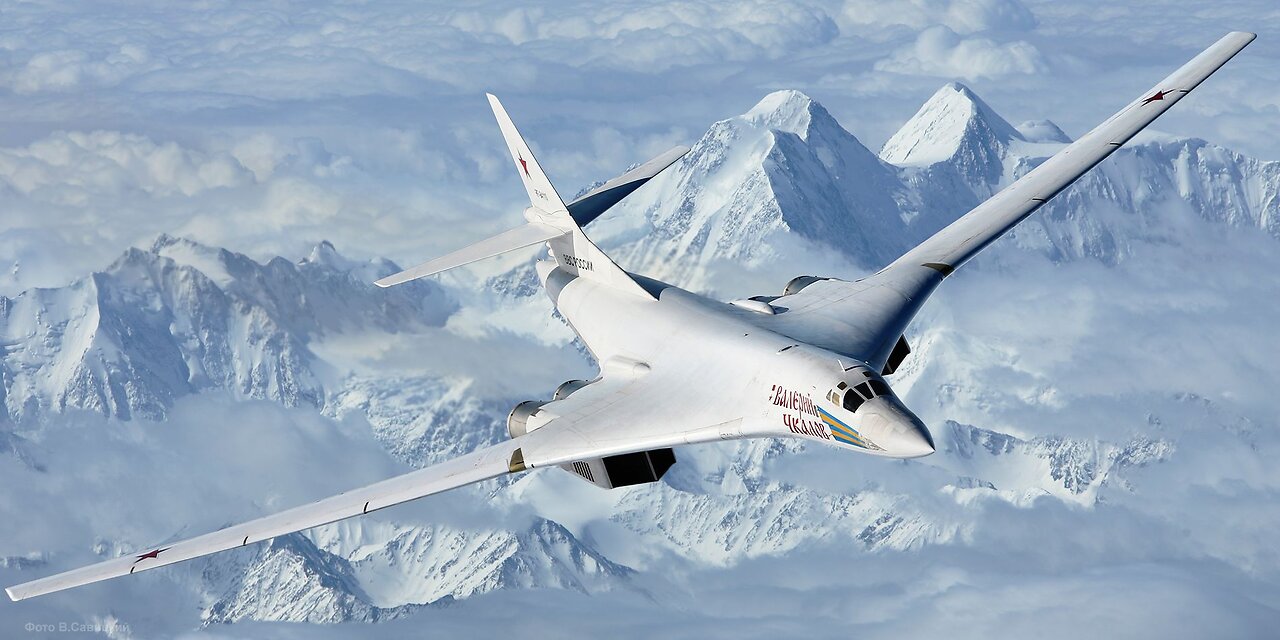Premium Only Content

Modernized TU - 160M "White Swan". (NATO designation Blackjack). Part of the Russian nuclear triad
Tu-160M is a supersonic, variable-sweep wing heavy strategic bomber
In late 2022, the first Tupolev Tu-160M strategic missile-carrying bomber, built anew, completed factory tests. During its test flight, the strategic bomber conducted maneuvers to check the aircraft’s stability and control in the air, the working capacity of its airborne systems and engines, and the onboard radio-electronic equipment.
In 2023 Russia’s new prototype Tu-160M bomber has completed its second test flight and will now undergo trials with the Defence Ministry.
Modernized systems and equipment make up 80% of the Tu-160M. Furthermore, the aircraft is using the new NK-32-02 engine, which itself will undergo flight tests.
The airframe of the Tu-160M did not change, and it’s unclear how the newly added technology will interact with the existing structure.
The first Tupolev Tu-160M strategic missile-carrying bomber built under the resumed production program has been named after the Soviet cosmonaut and the first woman in space, Valentina Tereshkova (the first woman in space).
The deep modernization of Tu-160M is based on the older version of the same aircraft Tu-160.
The Tu-160 is the world’s heaviest supersonic military aircraft with a variable-sweep wing.
The Tu-160 (NATO reporting name: “Blackjack” is a Soviet and subsequently a Russian supersonic variable-sweep wing strategic missile-carrying bomber. Along with the Tu-95MS bombers, these planes are the mainstay of the Russian Aerospace Force’s long-range aviation.
The Tu-160 is capable of reaching speeds greater than B-2-Spirits with a maximum speed of 1,382 miles per hour compared to B-2 630 miles per hour.
The B-2 can carry up to 40,000 pounds of ordnance in its weapon bays, but estimates put its true limit at around 50,000 pounds. The Tu-160 has a limit of 45,000 pounds.
With nearly 55,000 pounds of thrust produced at full afterburner, the Kuznetsov NK-32 engine, which was initially fitted to the Tu-160, is frequently regarded as the most potent combat aircraft engine.
Tu-160 can reach speeds of up to 2,200 kilometers per hour, the maximum height is 22 kilometers. Takeoff weight - 275 tons.
The Tu-160 strategic bomber first flew in 1981. In 2015, the Defence Ministry announced the launch of a program to create a new, modified version, dubbed Tu-160M, with plans to make 50 upgraded bombers.
The Tu-160M version is equipped with the new Novella NV1.70 fire control radar. The mechanical cockpit is replaced with a digital cockpit. In addition, the Tu-160M is also integrated with a new electronic communication and warfare system.
In addition to modernizing 16 existing Tu-160 bombers, Russia expects to purchase roughly 50 Tu-160M aircraft eventually. The serial production of the updated bomber is scheduled to start in 2023, with a minimum production rate of three aircraft per year.
The Tu-160M is reportedly armed with X-101 family cruise missiles that have both conventional (high-explosive, cluster, volumetric detonating) and nuclear (X-102) warheads.
These missiles can fit in 12 slots on the aircraft. According to some sources, a Tu-160 missile-carrying aircraft, specially modified for this role, was used to launch the first combat tests of these missiles in Syria.
Tu-160M is equipped with a new cruise missile, which is expected to be used by Russia’s new stealth long-range bomber. Among them, the Kh-101 missile with conventional warhead has undergone many tests on the Syrian battlefield and its range can be up to 5,000 kilometers. Meanwhile, the Kh-102 is an improved version of the Kh-101 that can carry a nuclear warhead.
The aircraft is also expected to carry the latest Russian-made hypersonic weapons.
Tu-160M is designed with two internal weapon bays, one in the front and the other in the rear of the fuselage, using rotary launchers. The aircraft can carry a total of 12 Kh-101/102 missiles. The combat radius of the Tu-160M is about 7,000 km, it can easily reach the entire west coast of the United States when taking off from the Russian Far East.
Compared with the radar, glass cockpit and avionics, the biggest challenge of the Tu-160M project was the improvement of the Kuznetsov NK-32 turbofan engine. The Kuznetsov NK-32, as installed in the original Tu-160, is widely reported as the most powerful combat aircraft engine in the world, developing over 55,000 pounds of thrust with afterburner.
The improvements over the initial design included new blades for the compressor and turbine, plus more efficient cooling.
Compared to the original NK-32, it improved thrust by 10%, and the range of the Tu-160M was increased by 1,000 kilometers.
-
 LIVE
LIVE
FyrBorne
1 hour ago🔴Warzone M&K Sniping: This May Be The Most Broken Update Yet
66 watching -
 10:59
10:59
Degenerate Jay
16 hours ago $1.45 earned007 First Light Is The James Bond Game Fans Deserve
19K2 -
 9:11
9:11
Faith Frontline
14 hours agoTucker Carlson SHOCKED As Cliffe Knechtle Reveals God’s Chosen People
6.81K6 -
 23:10
23:10
Jasmin Laine
17 hours agoCTV Host Visibly UNCOMFORTABLE As Guest Calls Canadians RACIST—Poilievre Leaves Them SPEECHLESS
12K6 -
 20:18
20:18
Fit'n Fire
17 hours ago $0.41 earned*NEW* CZ P10C OR Ported -- First 500 Rounds
7.32K1 -
 14:41
14:41
Nate The Lawyer
1 day ago $0.95 earnedWhy Hasn’t Raja Jackson Been Arrested Yet?
9.49K15 -
 6:04
6:04
Buddy Brown
2 days ago $1.36 earnedEugene’s SICK Newspaper Cover is a WARNING to Us All! | Buddy Brown
10.8K10 -
 16:23
16:23
Actual Justice Warrior
1 day agoMom Sucker Punched By Repeat Offender In Chicago
17.1K35 -
 56:28
56:28
Professor Nez
1 day ago🚨Not Only is Epstein NOT Going Away… It Just Got Worse!
28.8K27 -
 8:09
8:09
MattMorseTV
18 hours ago $11.57 earnedTrump scores 17th CONSECUTIVE Supreme Court VICTORY.
79.5K61